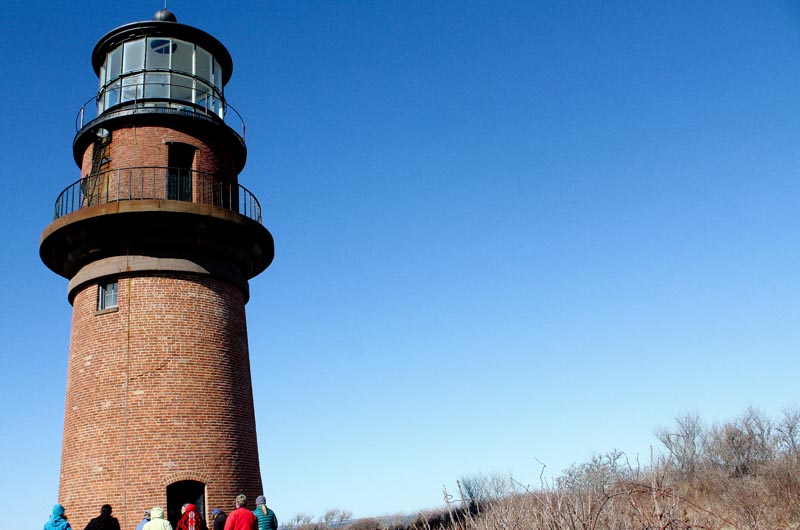The National Park Service has reviewed many applications to transfer ownership of lighthouses in the U.S., but none quite so urgent as the Gay Head Light, a historian for the park service said this week.
“Precarious,” said Alisa McCann, architectural historian for the northeast regional office of the park service, during a site visit to the old lighthouse on Wednesday.
“We have been pressured for other reasons, but never for erosion,” she said.
The park service has begun its review of the town’s application to take ownership of the lighthouse, which now stands 46 feet from the edge of the Gay Head Cliffs.
Plans are under way to move the lighthouse sometime in the next year.
Meanwhile, the town is in the middle of a lengthy process to take ownership of the light that began last August and involves a number of government agencies, including the Coast Guard, the General Services Administration and the U.S. Department of Interior, which oversees the park service.
During the site visit on a cold but sunny April day, Ms. McCann said the town is the sole qualified applicant to become the new owner of the lighthouse. And given the rapid erosion taking place at the cliffs, she said her office is working as fast as it can to move the application along.
She said the park service will likely have their portion of the review process completed by June, but she cautioned the committee that final approval could take longer than anticipated.
“I know we will impress upon the park service office the urgency and uniqueness of this,” she said.
Meanwhile, plans are in progress for the actual move of the lighthouse. The town is in talks with International Chimney, a company that specializes in moving large structures and moved the Schifter home on Chappaquiddick last summer. Intense studies are underway to determine the best site for relocating the tower, including a comprehensive geological study and pre-engineering study. The geological study is being done by a geologist with the U.S. Geological Survey.
And the studies are turning up some new information. Lenny Butler, chairman of the lighthouse building committee, said initial findings show that the lighthouse is currently sitting on a bed of silty sand from glacial deposits rather than clay, as originally thought. This means that when the lighthouse is relocated it will be less likely to disturb the cliffs.
Two sites are under consideration for the lighthouse’s new home. One is located 200 feet back from the cliff and sits about three feet lower in elevation than the current location. That site is also a silty sand bed with white clay 20 feet down, Mr. Butler said. The second site is 165 feet back from the cliff and is located in a dormant slide zone, with little erosion, Mr. Butler said. This area has loose, sandy soil, with a layer of red clay 20 feet below. Red clay is more plastic and slippery compared to white clay, Mr. Butler said. The second site would also require transporting the lighthouse via the road above the Aquinnah Circle.
A final geology report is due later this month.
Mr. Butler said the final site will be determined by a number of factors, including the long-term stability of the cliff area, continued use of the light as a navigational aid and the cost of the move.
Current estimates put the cost at about $3 million. Funding is expected to come from private fundraising as well as town and other public funds. At annual town meetings next week in West Tisbury, Oak Bluffs and Edgartown, voters will be asked to contribute Community Preservation Act funds to the project as part of a regional CPA initiative.








Comments (1)
Comments
Comment policy »